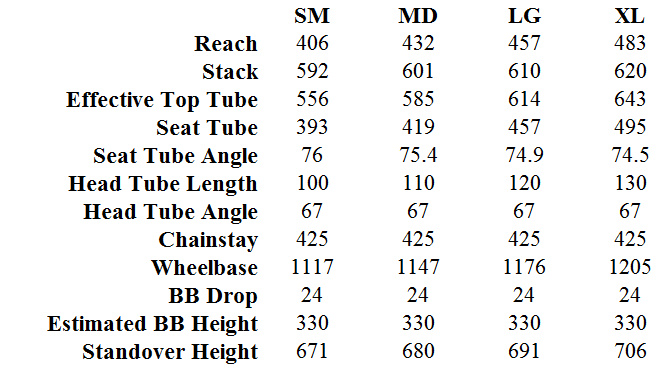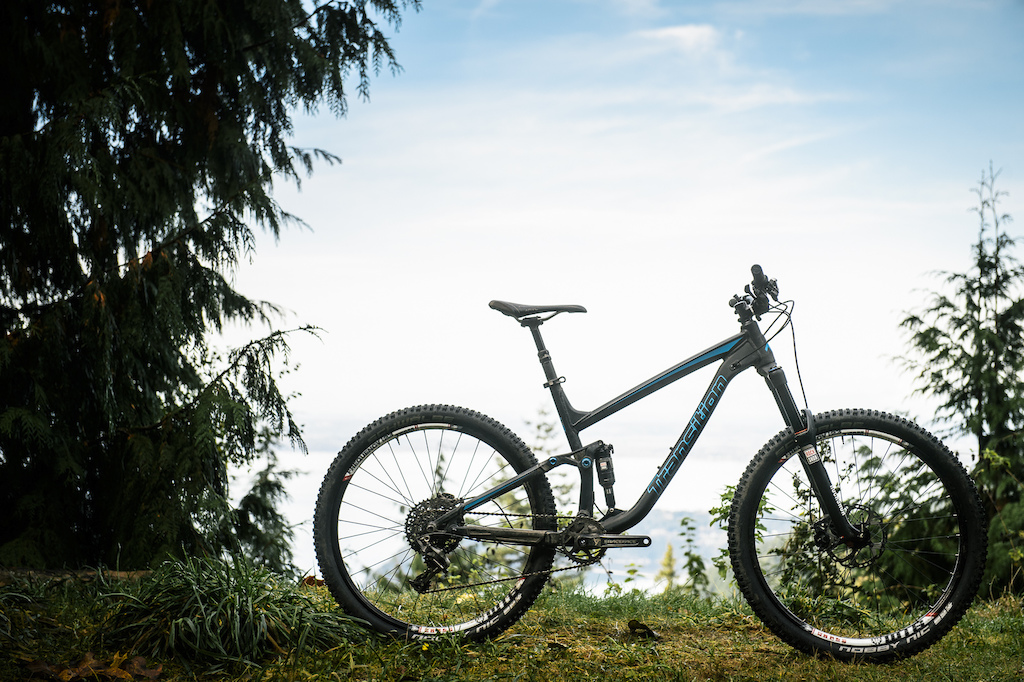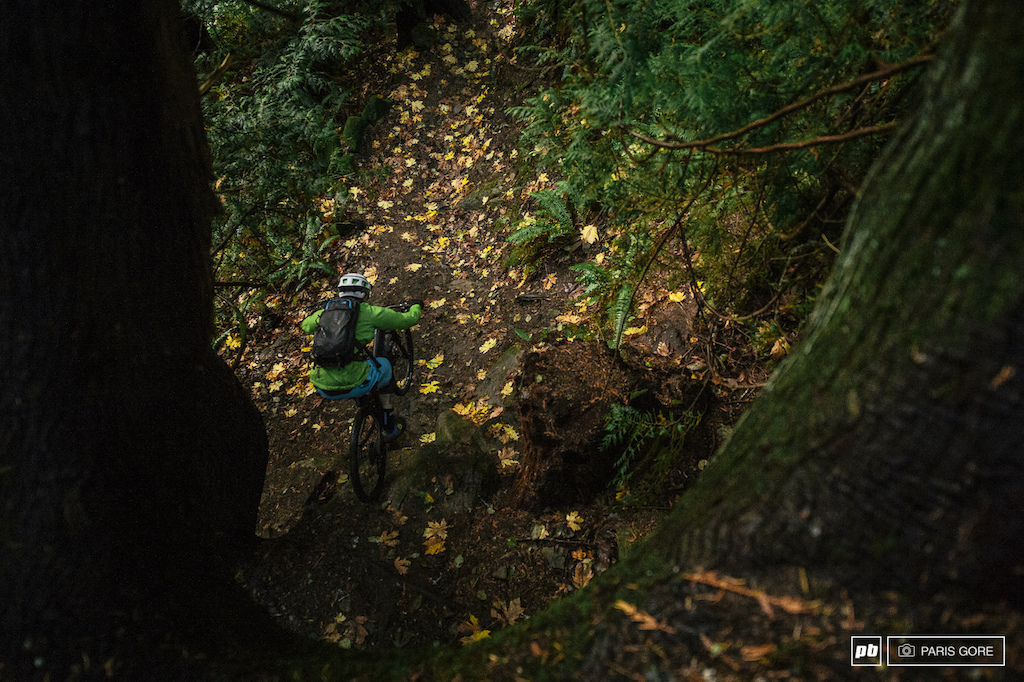Transition Scout 1 - Review
Transition completely overhauled their all-mountain and trail bike lineup for 2015, launching four new models based around a Horst Link suspension design, a departure from the company's previous link-driven single pivot configuration. The aluminum, 27.5" wheeled Scout has thoroughly modern geometry, with a long reach, low BB, and a slack head angle that's achieved by pairing a 140mm RockShox Pike RCT3 with a Monarch RT3 DebonAir shock that delivers 125mm of rear travel. The Scout 1 tested here retails for $4899 USD, and is available in four frames sizes with two color choices - Limeade or Satin Black. The price for a frame only with a Monarch RT3 DebonAir shock is $1799.

Transition Scout 1 Details
• Intended use: trail / all-mountain
• Wheel size: 27.5''
• Rear wheel travel: 125mm
• Aluminum frame
• GiddyUp Link suspension
• RockShox Pike RCT3 140mm fork
• Sizes: S, M, L, XL
• Weight: 29.5 lb (size L w/o pedals)
• MSRP: $4899 USD
• www.transitionbikes.com
Frame Design
Mountain bike geometry has undergone a shift over the last few seasons, and Transition has joined the growing number of companies producing bikes with long front centers, low bottom bracket heights, and short chain stays. In theory, this should provide better stability at speed, as well as allowing the bike to be run with a short stem without compromising its handling. This geometry has gained the most traction on bikes with 150-160+ millimeters of travel, but it's beginning to spread to shorter travel bikes like the Scout as well.
While it may not be breaking any new ground as far as aesthetics go, the Scout has a clean and aggressive look to it, with a top tube angle that provides plenty of standover clearance, and stout looking head tube junction. Even with the generous amount of standover, it's still possible to mount a full size water bottle on top of the down tube, which is a welcome sight, as is the use of a threaded, 73mm bottom bracket shell.

The Scout is purpose built for hard riding, with a beefy head tube junction and clevis style pivots in the rear
Internal cable routing is accomplished via a rectangular cut-out on each side of the top tube for brake and derailleur housing, and the seat tube is set up to run a stealth dropper post. Sealed cartridge bearings are used throughout the rear suspension linkage, and clevis style pivots along with a brace between the two seat stays are intended to add additional rear end stiffness. While both models of the Scout come equipped with 1x drivetrains, a front derailleur can be mounted for those riders who are still hesitant about giving up their extra front chain ring. ISCG 05 tabs are also in place for running a full or partial chain guide.
Suspension Layout
Transition's 'GiddyUp Link' is a play on words that refers to the use of a Horst Link suspension design. With the GiddyUp Link the rearmost pivots are located on the chain stays rather than the seat stays like Transition's previous bikes. When asked about the switch from their prior link-driven single pivot design to the new configuration, Kyle Young, co-owner of Transition, said, “We felt we could improve traction and control on technical singletrack climbing...and still have a lot of options for shock tuning to keep the suspension consistent feeling on the descents. We've been playing with different suspension layouts for years, and the time just wasn't right to change until now. The patent expiring was good timing, but it wasn't at all what drove the decision. It's a constant quest to improve the bike that drives this - if the Horst patent wasn't up, then it likely would have been a different layout that we would have employed."
As to how the positioning of the rear pivot was achieved, according to Kyle, “We experimented with a range of placements and ultimately the characteristics we wanted had to be worked out in the kinematics, and that's where Luke Beale (owner of Level One Engineering) helped a ton. Once the kinematics were dialed as best we felt they could be on paper, we made mules and tested a variety of configurations. Getting out there and actually riding different variations goes a long ways toward determining the end result as well, as you can only do so much on paper.”
For the best climbing and descending performance,Transition recommends running the Scout with 30% sag in the standing riding position, which should end up at or close to 35% sag when seated on level ground. This number correlates with the point at which the chain growth is greatest - as the bike goes past its sag point the rate of chain growth decreases, allowing the suspension to remain active for small and large bump absorption.
| |||||||||||||||||||||||||||||||||||||||||||||||||||||||||
Climbing
The Scout comes with a 760mm bar and a 45mm stem, a setup that works well with its geometry to create a climbing position that's comfortable whether standing or seated. Even with the long front center / short stem combination, getting enough weight over the front end on steep climbs wasn't any trouble, likely due in part to the bike's steep 74.9° seat tube angle. That angle helps keep the rider's weight centered when the seat post is at full extension, which aids in maintaining rear wheel traction without unweighting the front end.
Transition bills their GiddyUp Link suspension layout as being designed to be run fully open at all times, but on longer climbs I still preferred to run it in the middle compression setting to minimize the amount of suspension movement during out of the saddle pedaling. Think of the blue lever on the Monarch DebonAir shock as a traction control switch – open it up when you need maximum grip, and flip it to the middle setting when efficiency is more important than traction, whether that's during a long grind up a logging road or on a smoother stretch of singletrack. The suppleness of RockShox's new DebonAir is most often touted as benefiting downhill performance, but it works wonders on the ascents as well, allowing the Scout claw its way up nasty climbs with minimal effort thanks to the gobs of traction on tap. Of course, the Scout's weight does mean that it's not going to be quite as peppy of a climber as something a few pounds lighter, but I never felt held back by those extra grams, even on all-day rides that wracked up dizzying amounts of vertical, and the stout frame construction is well worth it as soon as the downhill portion of a ride begins.
Descending
The Scout may climb well, but it's an even better descender, exhibiting outstanding handling no matter how steep or technical the trail. I purposely took it on terrain I thought might rattle it, rough and tumble trails that would push most 5” bikes to their limits, but the Scout took it all in stride, refusing to flinch, even when faced with tight chutes bristling with jagged rocks. Even though there's a 15mm difference between the amount of fork and shock travel, the discrepancy wasn't noticeable on the trail, and the Scout felt extremely well balanced, with plenty of support even during repeated hard impacts. The Scout has the type of supportive feel you'd expect from a well tuned rally car, which allows it to skip over the rough stuff rather than getting bogged down in its travel, keeping it ready to take on the next impact. As with any bike in this class, it takes a little more finesse to get through really chopped up sections of trail, since 125mm of travel only goes so far, but it does feel like there's more than 5" of travel on tap, creating a greater cushion for those poor line choices. For the vast majority of the time the rear suspension felt invisible, sucking up bumps without any odd spiking or harshness. The instances when the rear shock did bottom out were all well deserved, occurring during landings into hard compressions that would have caused almost any bike to reach the end of its travel.
On trails that resemble a pump track, the Scout is a speed machine, and pushing into the backside of a roller generated a satisfying blast of forward motion. There wasn't any discernible frame flex during hard cornering, a trait that encouraged entering turns with more and more speed to see just how hard they could be leaned into. As an added bonus, the Scout is extremely quiet, completely free from any distracting rattling or clanging that can divert a rider's attention from the trail. Getting the bike airborne wasn't any trouble either - like an eager puppy straining at a leash, the Scout wants to leap upwards at the sight of any sort of takeoff. In fact, it's capable enough that I wouldn't hesitate to take it into a bike park to have a go on the flowier, jump filled trails, trails like Whistler's A-Line or Dirt Merchant where a longer travel bike isn't a necessity.
Component Check
• Schwalbe Nobby Nic Tires: Schwalbe's updated tread design broadens the range of conditions that the Nobby Nic is usable in, but it still wouldn't be on my short list of tires for wet conditions. On wet roots and rocks the side knobs had a tendency to let go with minimal warning, making it difficult to put much trust in them on those sloppy days. Once things dried out it was smoother sailing, and they felt more like the capable all-rounder they're intended to be.
• WTB i23 / DT Swiss Wheelset: The WTB rims held up to everything that was thrown at them, but the DT Swiss freehub on the rear wheel occasionally popped under heavy loads. It doesn't use the star ratchet system found on DT's higher end hubs that we've had good luck with, instead using a more traditional spring loaded pawl design.
• ANVL Rasp Grips: The Rasp grips are nice and thin, and use a simple one bolt lock-on design, but the rubber durometer is rather hard, which caused sore hands on longer rides.
• RockShox Monarch Debonair RT3: Even when set up with the generous amount of sag that Transition recommends, the Monarch Debonair provided excellent small bump sensitivity while still remaining able to handle larger impacts. There was a slight 'thunk' noise that occurred somewhere in the initial 40% of the stoke, one that was most noticeable when the shock was in the middle compression setting, but it didn't seem to have any affect on the shock's performance.
• Race Face Turbine Crank: Race Face's Turbine cranks are becoming a familiar sight on trail and all-mountain bikes, and for good reason. Their strength to weight ratio is excellent, and the Cinch System allows them to easily be set up to work with just about any chain ring / bottom bracket configuration imaginable.
Pinkbike's Take:
 | The concept of a shorter travel bike with long, low and slack geometry still raise questions, especially from riders who haven't experienced how much fun a bike like this is capable of delivering. There are bikes with more travel that weigh a similar amount, so given the choice, why would anyone want less travel? What it comes down to is how the bike feels on the trail - the Scout possess a mix of playfulness and brawn that's often lacking in longer travel bikes. This isn't a spineless noodle of a trail bike designed for puttering around on flow trails, it's a hot rod meant for going foot out, flat out whenever possible. But that doesn't mean it takes a breakfast of Pixy Stix and Red Bull to take advantage of the Scout's capabilities - even a less aggressive rider will be able to appreciate the ease at which the bike can cruise through technical terrain. Pumping through rollers, manualing out of corners, bunny-hopping over everything and anything that gets in the way - the Scout is one of those bikes that turns mountains into playgrounds, making the riding experience that much better. - Mike Kazimer |
Author Info:
Must Read This Week
How to Watch the 2024 Mountain Bike World Cup [Update: Staylive Offering Access in New Zealand, South Africa & More]
60397 views
60397 views
Sign Up for the Pinkbike Newsletter - All the Biggest, Most Interesting Stories in your Inbox
PB Newsletter Signup


 GiddyUp. The rear chainstay pivot is located ever-so slightly below the rear axle, a configuration that Transition decided on after multiple rounds of on-trail prototype testing.
GiddyUp. The rear chainstay pivot is located ever-so slightly below the rear axle, a configuration that Transition decided on after multiple rounds of on-trail prototype testing. 





 Member since Feb 1, 2009
Member since Feb 1, 2009
But I still love my Pitch, as long as the frame holds up to my abuse, I'll stick to it. Great allround bike.
I ride a FR/HT 7" does everything. Angle fire. Bootleg. Gnarnia
2. 140mm with 35% sag = 91mm
125mm with 35% sag = 81mm
- with 3 to 4 inches of remaining travel, I find it a hard pill to swallow that this bike is going to deliver.
I'm going to say it, Let's get back to enduro please. Don't worry, I'll down vote myself.
specialized enduro 650b
I have just ordered my yellow scout, arrives early January, can't wait !
This will be replacing my Transition Bandit. Ive been riding all types of MTBs for 18 years now and for years have had trail bikes with too much travel. The fact all of the travel only gets used on bad line choice or really hard flat landings here in NZ I cannot justify my daily steed to have 160mm travel. The Bandit is/was the perfect trail bike, all the right geometry & travel for my rowdiness style of riding. (All Mtn)
The Scout seems to be an even better make of the Bandit, can't wait to let her loose !
Props to sterlingmagnum and blitz66 and glenno and whomever else gets it.
My walmart bike from when I was a kid had internal cables. its nothing new lol
Most (90%) of my riding is stuff like Corner Canyon, Bobs, Round Valley, Flying Dog, Mid Mountain, Temple Quarry, etc. The exception riding is doing lift served days either at DV or Snowbird, or heading down to Moab a couple times a year.
Very interested in 125-130mm travel bikes due to this. Sure the 150-160mm travel bikes can pedal well, but overkill sometimes ruins the fun of the ride. Tested a Mach 6 up at Targhee and it was a blast ripping down the Super D trail, but tested it again at Bobs Basin and it was so much overkill wasn't all that much fun. But should I buy a bike for the 5-10% of the riding I do or for 90%? Can't afford two bikes unfortunately.
I would take an xfusion on it, but it better be a lower price point. Maybe a $2300 version. The 34 is not a fork I would drool over. The review say it rides low and dives.
Longer, but still not long. 437mm reach on an L size Nomad is not long.
This 125mm weights 29.5lbs while my burly 145mm with a f36 up front and cheaper components weights 29lbs (with pedals!). I'm far from being a weight weenie as I like my bikes built on the burlier side of things and I'm very curious about how the scout ride but the weight seems to be unexcusable.
Some 650Bs are on par with their respective 29er models, actually.
I heard/read somewhere that they climb nicely in the granny ring - (which if I recall correctly was a selling point for Specialized back in the day - they didn't bob so much when pedaling), but those are going away.
Sag does seem excessive...
Transition's bikes are getting longer, I am personally confused as to what size i need
Kona process in large is same size as a Transition in medium ?
Both share similar ethos of long top tube, short stem and chainstay
Need demo days Transition!!
In Summary: Huge Fun and Playful nature once setup to taste. Climbing not its natural habitat, but will get you to the top relatively efficiently. Deposit placed.
buying Christmas presents for yourself is the best
Im 5'10'' so right in the middle ground...
Thanks!!
Thanks in advance!
Im 5ft6" Size Medium running a 40mm Stem
Transitions website is useful for sizing and especially Sag set up !!
Now whole build on Hiphop is beefier while this bike saves almost 2lbs on tyres alone.
Then I am sorry to ruin it for you Royal but suspension design of FSR and one on Commencal (or Kona) are nearly identical. It is the shock and it's setup that decides how the bike rides. Well setp CCDB or Pushed Float on Orange Five will outperform Bronson with stock shock - as simple as that.
I guess what I'm trying to say is that there is no point putting down a bike because of its linkage type, because its more about the overall intended suspension design (efficient pedal platform or good small bump performance as one example of trade offs to be considered). Also, having a quality rear shock with a good tune suited to your riding style makes a huge difference.
ZeGermans, perhaps we are talking about the same thing (I don't really buy Joe Graneys concepts like Instant Center) but I'd say that pedalling efficiency depends on how the shock gets compressed between Sag point and midstroke. Whether it is a FSR or VPP is not so relevant. Depending on how you mount the shock to the frame makes a lot of difference. For instance, let's take Trek Remedy and it's ABP where shock is mounted to the link and to the chainstays. You could find several mounting locations for the shock on the front triangle instead of CS that would give you same leverage ratio and travel. So with same pivot locations you'd get different characteristics. Now we can take shock setup where stock shocks are made to give wide range of adjustability for riders of wider spectrum of weights vs tailored valve ports and shimstack. PUSH does nothing more but increases the oil flow through the valve and shims it precisely, which would simply not work for mass market. Thanks to that you can ride your bike in your body with full climb mode, yet the oil flowing through large ports will break through low speed compression stack and take the hit in a relatively plush manner. In this way you have a shock that runs more low speed compression for pedalling than stock, yet it provides more suppleness on even medium hits than stock shock in half open mode. That is unachievable on stock design even though some companies like TREK are working hard on it. All that aside of whole frame geometry, wheels, tyres, cockpit setup and what the fork is doing. Suspension systems have pluses and minuses but are generally overrated
I was honestly thinking "maybe I will sell all my bikes and start my stable over" this season... I have a Moorewood DH whip, a Sinister 6" AM bike, a 5" BMC, a DMR hardtail, and a Trek 2100 road bike... If I sold all of them, it wouldn't even cover this single bike.
I love this sport, but I honestly don't think I'll ever be able to afford a nice, complete bike again.